How to Prioritize Customer Feedback: A Strategic Framework for Insights Pro
Have you ever felt like you're drowning in customer feedback, unsure which insights actually matter? Market research professionals know the struggle: hundreds of survey responses, support tickets, and user comments piling up, each seeming equally important—but resources are limited.
The harsh reality is that most organizations miss critical strategic opportunities because they lack a structured approach to prioritizing customer feedback. Without a systematic method, teams default to addressing the loudest voices or the most recent complaints, potentially overlooking transformative insights that could drive genuine product innovation and competitive differentiation.
What if you could transform that overwhelming sea of feedback into a precise, actionable roadmap? A strategic framework that not only helps you sift through the noise but empowers your team to make data-driven decisions that directly impact product development, customer satisfaction, and market positioning?
Understanding the Customer Feedback Prioritization Challenge
Root Causes: Why Customer Feedback Management Falls Apart
Customer feedback mismanagement stems from several critical organizational gaps that plague B2B businesses and SMBs:
- Fragmented Feedback Collection: Insights scattered across multiple channels like support tickets, sales conversations, survey responses, and social media create information silos.
- Lack of Standardized Assessment Criteria: Without clear evaluation metrics, teams struggle to objectively rank and assess feedback relevance.
- Resource Constraints: Limited time and personnel mean most organizations default to reactive instead of strategic feedback processing.
- Insufficient Technical Infrastructure: Manual feedback tracking systems lead to inefficient, error-prone analysis processes.
Telltale Symptoms of Ineffective Feedback Management
B2B organizations experiencing feedback prioritization challenges often exhibit these recognizable patterns:
Reactive Product Development
Constantly chasing individual customer requests without a cohesive strategy, resulting in fragmented product roadmaps that lack strategic coherence.
Decision Paralysis
Leadership teams overwhelmed by conflicting feedback, leading to prolonged deliberation and missed market opportunities.
Resource Misallocation
Disproportionate time and energy spent addressing low-impact feedback while critical strategic insights remain unexamined.
Strategic Implications: The High Cost of Neglecting Systematic Feedback Prioritization
Failing to develop a robust feedback prioritization framework carries significant strategic risks for B2B organizations:
Competitive Disadvantage
Competitors who efficiently translate customer insights into product innovations will consistently outmaneuver organizations trapped in reactive feedback cycles.
Customer Retention Challenges
Inconsistent or slow response to meaningful feedback signals organizational indifference, potentially accelerating customer churn rates.
Innovation Stagnation
Without structured feedback analysis, product development becomes incremental rather than transformative, limiting long-term growth potential.
Understanding these root causes, symptoms, and strategic implications provides the foundation for developing a systematic approach to customer feedback prioritization—transforming raw data into actionable strategic intelligence.
A Strategic Framework for Prioritizing Customer Feedback

Step 1: Centralize and Standardize Feedback Collection
Create a unified feedback repository that consolidates insights from multiple channels. Develop a standardized input template that captures:
- Feedback source (support ticket, survey, direct communication)
- Customer segment and persona
- Potential business impact
- Alignment with strategic objectives
Step 2: Implement a Systematic Scoring Mechanism
Design a quantitative evaluation framework using a multi-dimensional scoring system:
Strategic Alignment (0-3 points)
Assess how closely feedback aligns with current product roadmap and company vision.
Revenue Potential (0-3 points)
Evaluate potential impact on customer retention, upselling, or new market expansion.
Implementation Complexity (0-3 points)
Rate feasibility of addressing feedback based on technical and resource constraints.
Recommended Tools for Feedback Management
- UserVoice: Centralized feedback collection and prioritization platform
- Productboard: Advanced insight management with strategic alignment tracking
- Qualtrics: Comprehensive feedback analysis and scoring tools
Critical Implementation Considerations
Cross-Functional Collaboration
Ensure product, sales, and customer success teams collaborate in feedback evaluation to provide holistic perspectives.
Regular Calibration
Quarterly review and refinement of your scoring mechanism prevents methodology stagnation and maintains relevance.
By implementing this structured approach, B2B organizations can transform customer feedback from overwhelming noise into strategic, actionable intelligence.
Strategic Applications: Navigating Implementation Challenges
Obstacle Identification: Real-World Feedback Prioritization Hurdles
Resistance to Systematic Change
Team members accustomed to ad-hoc feedback handling may resist structured evaluation processes, perceiving them as bureaucratic and time-consuming.
Data Quality and Consistency
Inconsistent feedback collection methods and varying data granularity can undermine the reliability of your prioritization framework.
Technology Adoption Barriers
Limited technical expertise or budget constraints might impede seamless implementation of advanced feedback management tools.
Stakeholder Alignment
Divergent perspectives across departments can create friction in establishing a unified approach to feedback evaluation.
Pragmatic Workarounds: Overcoming Implementation Obstacles
Change Management Strategy
Develop a phased rollout of the feedback framework, starting with a pilot team. Create visual dashboards demonstrating tangible benefits to build organizational buy-in. Host interactive workshops illustrating how the new approach saves time and drives strategic insights.
Data Standardization Protocol
Create a comprehensive feedback template with mandatory fields and dropdown selections. Implement validation rules that ensure minimum data quality. Conduct periodic data hygiene training to maintain consistency across feedback collection points.
Scalable Technology Approach
Begin with cost-effective, modular tools that offer free tiers or flexible pricing. Leverage open-source alternatives or integrated features within existing CRM systems. Prioritize platforms with intuitive interfaces that minimize technical training requirements.
Cross-Functional Alignment Workshop
Design collaborative sessions where representatives from product, sales, customer success, and support co-create the feedback evaluation criteria. Establish clear communication protocols and shared performance metrics that incentivize collective ownership of customer insights.
Strategic implementation requires anticipating and proactively addressing potential roadblocks in your feedback prioritization journey.
Tangible Benefits: Transforming Customer Feedback into Strategic Advantage
Implementing a structured customer feedback prioritization framework delivers measurable, game-changing outcomes for B2B organizations:
Accelerated Product Innovation
Organizations report up to 40% faster product development cycles by systematically filtering and addressing high-impact customer insights. This translates directly into competitive market positioning and reduced time-to-market for critical feature enhancements.
Enhanced Customer Retention
Companies utilizing strategic feedback frameworks experience 25-35% improvement in customer satisfaction scores. By demonstrating responsive, intelligence-driven product evolution, businesses create stronger emotional connections with their customer base.
Operational Efficiency Gains
Centralized feedback management reduces operational overhead by 50% in manual sorting and processing time. Cross-functional teams can reallocate saved resources toward high-value strategic initiatives instead of administrative feedback management.
Targeted Impact Across Business Functions
- Product Teams: Clear prioritization roadmaps with data-driven feature development strategies
- Sales Teams: Enhanced understanding of customer needs, enabling more precise targeting
- Customer Success Teams: Proactive issue resolution and personalized engagement models
- Executive Leadership: Real-time market intelligence for strategic decision-making
Beyond quantitative metrics, the framework provides a sustainable mechanism for continuous organizational learning and adaptive market responsiveness.
Key Takeaways: Elevating Customer Feedback Prioritization
Transforming customer feedback into strategic intelligence requires a nuanced, multi-dimensional approach that goes beyond traditional scoring mechanisms. By integrating quantitative impact metrics with qualitative strategic alignment, market research professionals can create a dynamic prioritization framework that not only captures immediate customer needs but also anticipates future market trends. The most successful organizations view feedback prioritization as a continuous, iterative process that bridges customer experience, product development, and strategic innovation. This holistic methodology ensures that every piece of customer input is evaluated through multiple lenses—business impact, feasibility, strategic alignment, and potential competitive advantage—ultimately enabling teams to make data-driven decisions that drive meaningful product evolution and sustained market differentiation.
